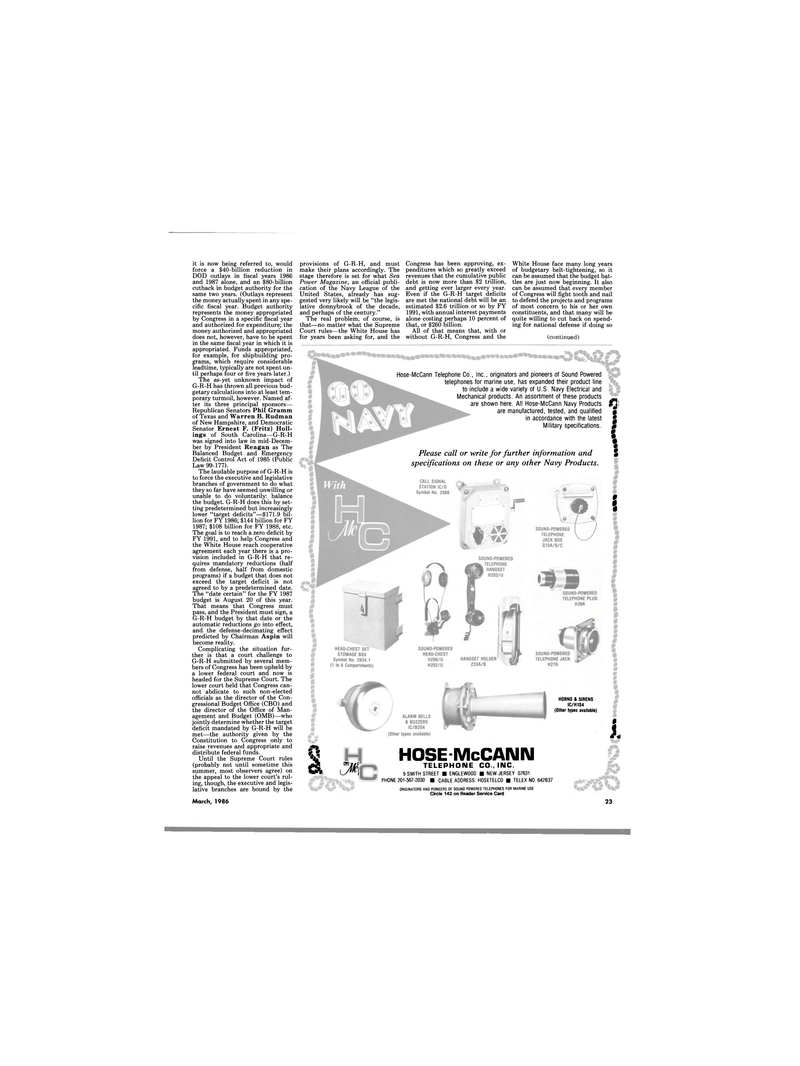
Page 21: of Maritime Reporter Magazine (March 1986)
Read this page in Pdf, Flash or Html5 edition of March 1986 Maritime Reporter Magazine
it is now being referred to, would force a $40-billion reduction in
DOD outlays in fiscal years 1986 and 1987 alone, and an $80-billion cutback in budget authority for the same two years. (Outlays represent the money actually spent in any spe- cific fiscal year. Budget authority represents the money appropriated by Congress in a specific fiscal year and authorized for expenditure; the money authorized and appropriated does not, however, have to be spent in the same fiscal year in which it is appropriated. Funds appropriated, for example, for shipbuilding pro- grams, which require considerable leadtime, typically are not spent un- til perhaps four or five years later.)
The as-yet unknown impact of
G-R-H has thrown all previous bud- getary calculations into at least tem- porary turmoil, however. Named af- ter its three principal sponsors—
Republican Senators Phil Gramm of Texas and Warren B. Rudman of New Hampshire, and Democratic
Senator Ernest F. (Fritz) Holl- ings of South Carolina—G-R-H was signed into law in mid-Decem- ber by President Reagan as The
Balanced Budget and Emergency
Deficit Control Act of 1985 (Public
Law 99-177).
The laudable purpose of G-R-H is to force the executive and legislative branches of government to do what they so far have seemed unwilling or unable to do voluntarily: balance the budget. G-R-H does this by set- ting predetermined but increasingly lower "target deficits"—$171.9 bil- lion for FY 1986; $144 billion for FY 1987; $108 billion for FY 1988, etc.
The goal is to reach a zero deficit by
FY 1991, and to help Congress and the White House reach cooperative agreement each year there is a pro- vision included in G-R-H that re- quires mandatory reductions (half from defense, half from domestic programs) if a budget that does not exceed the target deficit is not agreed to by a predetermined date.
The "date certain" for the FY 1987 budget is August 20 of this year.
That means that Congress must pass, and the President must sign, a
G-R-H budget by that date or the automatic reductions go into effect, and the defense-decimating effect predicted by Chairman Aspin will become reality.
Complicating the situation fur- ther is that a court challenge to
G-R-H submitted by several mem- bers of Congress has been upheld by a lower federal court and now is headed for the Supreme Court. The lower court held that Congress can- not abdicate to such non-elected officials as the director of the Con- gressional Budget Office (CBO) and the director of the Office of Man- agement and Budget (OMB)—who jointly determine whether the target deficit mandated by G-R-H will be met—the authority given by the
Constitution to Congress only to raise revenues and appropriate and distribute federal funds.
Until the Supreme Court rules (probably not until sometime this summer, most observers agree) on the appeal to the lower court's rul- ing, though, the executive and legis- lative branches are bound by the
March, 1986 provisions of G-R-H, and must make their plans accordingly. The stage therefore is set for what Sea
Power Magazine, an official publi- cation of the Navy League of the
United States, already has sug- gested very likely will be "the legis- lative donnybrook of the decade, and perhaps of the century."
The real problem, of course, is that—no matter what the Supreme
Court rules—the White House has for years been asking for, and the
Congress has been approving, ex- penditures which so greatly exceed revenues that the cumulative public debt is now more than $2 trillion, and getting ever larger every year.
Even if the G-R-H target deficits are met the national debt will be an estimated $2.6 trillion or so by FY 1991, with annual interest payments alone costing perhaps 10 percent of that, or $260 billion.
All of that means that, with or without G-R-H, Congress and the
White House face many long years of budgetary belt-tightening, so it can be assumed that the budget bat- tles are just now beginning. It also can be assumed that every member of Congress will fight tooth and nail to defend the projects and programs of most concern to his or her own constituents, and that many will be quite willing to cut back on spend- ing for national defense if doing so (continued)
Hose-McCann Telephone Co., Inc., originators and pioneers of Sound Powered telephones for marine use, has expanded their product line to include a wide variety of U.S. Navy Electrical and
Mechanical products. An assortment of these products are shown here. All Hose-McCann Navy Products are manufactured, tested, and qualified in accordance with the latest
Military specifications.
Please call or write for further information and specifications on these or any other Navy Products.
HORNS & SIRENS
IC/H1S4 (Other types available) § d CM HOSE-McCANN TELEPHONE CO., INC. 9 SMITH STREET • ENGLEW00D • NEW JERSEY 07631
PHONE 201-567-2030 • CABLE ADDRESS: H0SETELC0 • TELEX NO. 642837
ORIGINATORS AND PIONEERS OF SOUND POWERED TELEPHONES FOR MARINE USE
Circle 142 on Reader Service Card 0 1 \ i. 23

 20
20

 22
22
